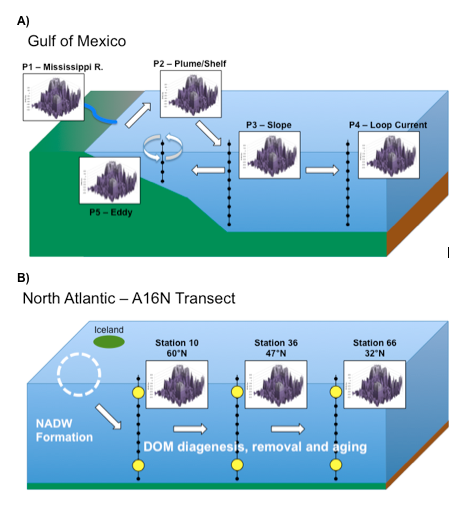Reports: ND255430-ND2: Molecular-Level Composition and Cycling of Dissolved Protokerogen: A Combined Nuclear Magnetic Resonance and Carbon Isotopic Study
Ellen R. M. Druffel, University of California (Irvine)
The scientific objective of this study is to quantify relationships between dissolved organic carbon (DOC) molecular-level composition (via 1H-NMR spectroscopy) and radiocarbon (14C) age in several marine environments. In particular, we are studying the formation, diagenesis and removal mechanisms of recalcitrant DOC (i.e. carboxylic-rich alicyclic molecules; CRAM). Recalcitrant DOC can also be absorbed and transported by sinking particles and preserved in marine sediments. This dissolved protokerogen can influence the oceanic kerogen reservoir on geological timescales.
To date, we have accomplished approximately half of the goals that we proposed. We have measured seawater samples from the North Atlantic and the Gulf of Mexico for DOC ∆14C and d13C signatures and published some of these results. We have made progress toward developing the capability to make 1H-NMR measurements at UCI on seawater samples. Details of our progress in year-1, and plans for year-2 appear below.
We have published the results of DOC ∆14C and d13C measurements made in the North Atlantic (Druffel et al 2016 GRL). We found that >10% of the DOC in the deep North Atlantic is of post-bomb origin and that the 14C age of the pre-bomb DOC is ≥4900 14C years, 900 14C years older than previous estimates. We concluded that prebomb DOC 14C ages are older and a portion of deep DOC is more dynamic than previously reported. This is important because it tells us that there is a surface-derived source of DOC in the deep sea. We have also analyzed the black carbon fraction of DOC for 14C and found ancient ages (23,000 14C years) in the deep Atlantic (Coppola and Druffel, 2016). We have measured ∆14C and d13C of water samples from the Mississippi River, river plume/shelf, slope and offshore Loop Current sites in the Gulf of Mexico (Walker et al Nature Geoscience, in revision). We find that DOC ∆14C values decrease with distance from the river mouth, and that there are similar ∆14C values found in the deep Gulf of Mexico and the deep Carribean Sea.
Dr. Walker is working with Dr. Hussein Abdulla (Texas A&M University, Corpus Christi) to learn how to analyze seawater samples using 1H-NMR spectroscopy to obtain an understanding of how the molecular structure of DOC changes in its transfer from riverine, to estuarine, to open ocean pools. We are still refining the water suppression method at UCI to obtain adequate spectra for our seawater samples. I am very excited about the new approach that this opportunity provides for our research on refractory DOC (protokerogen) in riverine and oceanic systems of the Gulf of Mexico and the North Atlantic.
This study will help answer fundamental questions involving the production, diagenesis and preservation of marine DOC. In particular, we are focusing on understanding the formation and removal mechanisms of recalcitrant DOC (RDOC). RDOC is a contributor of pre-aged, organic matter to sinking particulate organic matter. In this way, RDOC is an important source of protokerogen preserved in marine sediments over geologic timescales.
Over 85% of the proposed funding is being used specifically for the advanced education of one graduate research fellow (Christian Lewis) and one undergraduate research assistant. Christian Lewis is learning how to conduct DOC isotopic analyses and molecular level characterizations of our seawater samples. Mr. Lewis and Dr. Walker are collecting more samples on a cruise in the South Pacific in fall 2016, which will include a new solid phase extraction technique that will be valuable for extracting protokerogen-like material from seawater. DOC extracted using this technique will be subjected to molecular level characterization using 1H-NMR and incorporated into the results obtained from the ACS PRF study.












